SPECIAL TOOL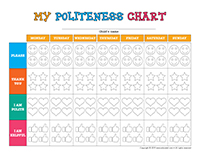
This tool was created in response to a special request received. (Open politeness coloring chart) Print for each child. Use the chart daily to encourage children to be polite. Invite them to color one box every time they demonstrate politeness. At the end of the week, discuss results.
CIRLCE TIME
The tube of toothpaste
During circle time, press the contents of a tube of toothpaste onto a paper plate. Invite children to take turns pressing the toothpaste out until it is empty. Next, ask them how you could put the toothpaste back in the tube. If they have suggestions, test them. Once children understand that putting the toothpaste back inside the tube is impossible, explain how the same is also true for mean words and actions. Once they have been said or done, we can’t put them back in our mouth or take them back. That is precisely why it is so important to think before we speak and act.
Crumpled heart exercise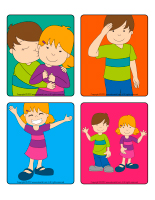
During circle time, give each child a pretty pink or red paper heart. Ask children which emotions they associate with a heart: love, joy, happiness, etc. Invite them to draw a smiling face on their heart. Next, ask them to crumple their heart and form a ball in the palm of their hand. Once this is done, ask children to try to remove the wrinkles from their paper heart. Can they make them all disappear? Of course not. The heart will never be as pretty, like it was before it was crumpled. Use this exercise to explain to your group how lack of politeness and not being nice to others can “wrinkle” their heart and make them sad.
Animated discussion-Politeness
(Open picture game-Politeness) Print and laminate the pictures in the format you prefer. Use them to spark a discussion with your group and ask children questions about politeness to see what they know about manners.
AREA SETUP
Thematic poster-Politeness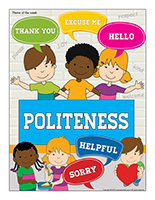
(Open thematic poster-Politeness) Print and display to present your theme and decorate your daycare.
Stickers-Politeness
(Open stickers-Politeness) Print on adhesive paper and use the designs to create an original sticker collection.
Educa-decorate-Politeness
(Open educa-decorate-Politeness) Print, cut out, and laminate. Decorate the walls of your daycare and hang decorations from the ceiling to set the mood for the theme.
Educa-theme-Politeness
(Open educa-theme-Politeness) Print and laminate the various elements. Use them to present the theme to your group (and parents) and decorate your daycare.
Garland-Politeness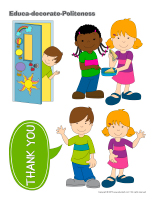
(Open models-Politeness) Print and let children decorate the elements. Use them to create a garland that may be hung within your daycare or near your daycare entrance.
Pennants-Politeness
(Open pennants-Politeness) Print and have children cut out the pennants. Hang them within your daycare to form a garland.
Politeness mural
Cut several pictures out of magazines and ask children to use them to create a politeness mural. Under each picture, write a word associated with politeness. Add children’s drawings and pictures of your group taken throughout the theme.
PICTURE GAME
Picture game-Politeness
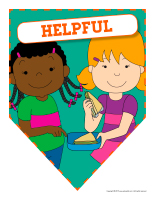
The pictures may be used as a memory game or to spark a conversation with the group. Use them to decorate the daycare or a specific thematic corner. (Open picture game-Politeness) Print, laminate, and store in a “Ziploc” bag or in your thematic bins.
Memory game-Politeness
(Open picture game-Politeness) Print two copies and use the cards for a memory game.
ACTIVITY SHEETS
Activity sheets-Politeness
Activity sheets are provided for each theme. Print and follow instructions. (Open activity sheets-Politeness)
Educa-spots-Politeness
(Open educa-spots-Politeness) Print for each child. Use bingo markers to add color inside the circles. If you don’t have bingo markers, simply have children press stickers or dry cereal inside the circles.
WRITING ACTIVITIES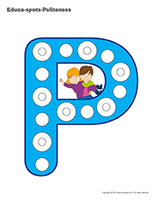
Writing activities-P like Politeness
(Open writing activities-P like Politeness) Print for each child or laminate and use with a dry-erase marker.
Educa-nuudles-Politeness
(Open educa-nuudles-Politeness) Print for each child. Have children color the sheet and use Magic Nuudles to give it a three-dimensional look. Variation: You don’t have Magic Nuudles? Have children fill the spaces designed for Magic Nuudles with bingo markers or stickers.
To order Magic Nuudles
LANGUAGE ACTIVITIES
Word flashcards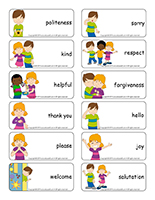
Use the flashcards to spark a conversation with your group, in your reading and writing corner, or to identify your thematic bins. (Open word flashcards-Politeness) (Open giant word flashcards-Politeness) Politeness, kind, helpful, thank you, please, welcome, sorry, respect, forgiveness, hello, joy, salutation
Let’s chat
Print and laminate the word flashcards. Children take turns picking a word flashcard and presenting it to the group. Together, identify facts and details related to each word. Ask questions to encourage children to talk.
Educa-chatterbox-Politeness
(Open educa-chatterbox-Politeness) Print and laminate the cards. To create your chatterbox, you will need an empty shoebox or a small bin that you can decorate as you see fit. Fill it with tiny objects, illustrations, pictures, and accessories related to your theme. To help you, we have created a series of cards that you may use. During circle time or, for example, when children are waiting for their lunch, have them take turns picking a card or object out of your chatterbox and naming the corresponding item.
Story and memory game-Politeness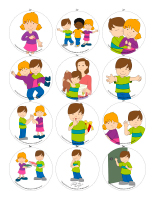
(Open story and memory game-Politeness) Print, laminate, and cut out the cards. Arrange them face down on the floor or on a table. Children take turns picking three cards and using the illustrations to invent a story.
Trick: To solidify the cards, glue each one on the top of a frozen juice can.
Tracing words-Politeness
(Open word flashcards-Politeness) (Open giant word flashcards-Politeness) Print several word flashcards. Glue them on pieces of paper, laminate them, and arrange them in a binder. Show children how they can trace the words using dry-erase markers. If you wish, leave room under each word so children can try to write the words without tracing the letters.
ROUTINES AND TRANSITIONS
Game-This is my spot-Politeness
(Open transition games-Politeness) Print each illustration twice. Use adhesive paper to secure one copy of each illustration on the table. Deposit the second copy of each illustration in an opaque bag and invite children to pick a card that will determine their spot at the table (corresponding illustration). The illustrations can also be used to determine children’s naptime spots or their place in the task train.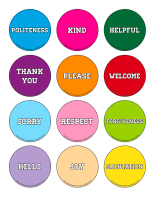
Politeness hunt
(Open transition games-Politeness) Print, laminate, and arrange the illustrations on the floor to create a path that leads to various areas within your daycare. The path can lead to areas that are frequently visited by the children in your group each day, such as the bathroom and the cloakroom. If you prefer, the illustrations can be used to delimit certain areas.
Politeness menu
(Open menu-Politeness) Print for each child. Invite children to glue their menu on a piece of black construction paper. Laminate the menus. At lunch time, set a menu in front of each child. Read the menu with your group. Each child must select a mark of courtesy that he or she will try to integrate during the meal. Have each child draw a symbol next to the mark of courtesy of his or her choice. Congratulate children for their efforts throughout the meal.
Hold the door!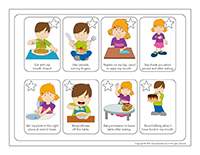
During transitions, invite a child to play the role of the group’s doorman. The child will be responsible for opening and closing the door, but also for holding it open while the group is going in or out. Encourage the other children to thank the doorman as they walk by.
PHYSICAL ACTIVITIES AND MOTOR SKILLS
Excuse me
To demonstrate the importance of saying “excuse me” when they wish to walk past someone or when they require someone to move out of their way, invite children to stand in a horizontal line, next to each other. Have them hold hands. Stand behind your group, between two children, and say “excuse me”. The children will have to let go of their hands and make room for you to walk between them. Invite one of the children to take your place. Children must only let their peers go through if they say “excuse me”.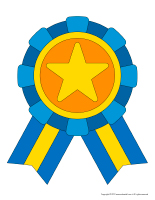
Bumper cars
Give each child a hula hoop and invite them to stand inside it, holding it around their waist. Explain how the hula hoop represents their car. When you give the signal, children must walk within a delimited area, representing a bumper car arena. Every time their hula hoop touches another child’s hula hoop, they must say “excuse me”. Use this activity to help children understand how they must say these words when they bump into someone. The hula hoops will ensure that children don’t hit each other too hard.
Modeling dough activity placemats-Politeness
(Open modeling dough activity placemats-Politeness) Print and laminate. Let children pick a placemat and provide modeling dough. Encourage them to use the dough to fill or reproduce the shapes that are on their placemat.
Educ-clothespins-Politeness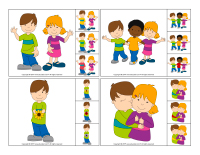
(Open educ-clothespins-Politeness) Print and laminate. Children must find and identify the correct item using a clothespin.
Giant homemade memory game-Politeness
(Open picture game-Politeness) Use 12 paper plates (same color) to create six pairs of different pictures. Arrange all the plates upside down on the floor or on a table (so you cannot see the pictures). Children take turns turning two plates. Every time a child finds two identical pictures, he keeps them and plays again. If a child turns two different pictures, his turn is over.
String activities-Politeness
(Open string activities-Politeness) Print for each child. Children trace the lines with waxed string (Wikki Stix). Variation: Trace the lines with glue and press string on the glue-covered lines.
Wikki Stix are sold on the educatall online store.
Let’s play store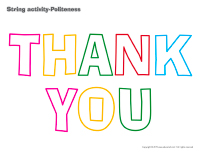
Use different food items or toys that you have on hand. Play the role of the storekeeper. Children must request the items they wish to buy. Encourage them to use “please” and “thank you”. If you wish, you can let children play the role of the storekeeper too.
“Please” and “thank you”
(Open game-Politeness) Divide your group into two teams: a “Please” team and a “Thank you” team. Set these phrases as well as a few other ones in a bag. Pick a phrase and read it out loud. When the “Please” team hears you say “please”, its members must quickly stand up and sit back down. When the “Thank you” team hears you say “thank you”, its members must quickly stand up and sit back down. When you read any other phrase, both teams must remain seated.
The social skills die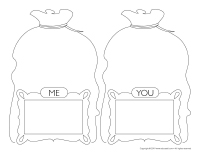
(Open social skills die) Print, laminate, and cut out the pictures. Glue each one on a different side of a square cardboard box that you have wrapped in colorful paper. Children take turns rolling the die you have created. They must mime the illustrated social skill the die lands on so that their peers can identify it.
COGNITIVE ACTIVITIES
Portion dividing-Politeness
(Open portion dividing-Politeness) Print for each child. Invite them to draw themselves in the frame that has “Me” written on it and draw one of their friends in the frame that has “You” written on it. Next, have them color and cut out the candy pieces that are on the second page before distributing them among both bags. Explain how, when we share, it is nice to always offer our friend the first and last item. For this reason, children should begin by gluing one candy piece in their friend’s bag before gluing one in their own bag. If they respect your friendly advice, their friend should end up with one more candy piece. Help children notice this fact and discuss the situation as a group.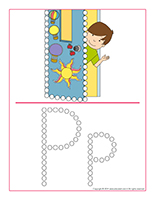
Educa-dots-Politeness
(Open educa-dots-Politeness) Print for each child. Give each child a tiny bowl filled with poster paint and a cotton swab. They must dip their cotton swab in the paint and then on each dot to color the letters or items. Let dry and display. Use their work to name the letters or items with your group.
Counting cards-Politeness
(Open counting cards-Politeness) Print and laminate. Prepare a series of wooden clothespins on which you have written or painted numbers 1-9. Children must count the items on each card and place the corresponding clothespin on the correct number.
Color by number-Politeness
(Open color by number-Politeness) Print for each child. Have children color the picture per the color code.
Snakes & ladders-Politeness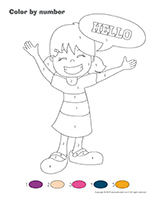
(Open snakes & ladders-Politeness) Print and laminate. Children use a die and small figurines to represent playing pieces.
Homemade wooden puzzles
Print several pictures representing politeness. Color them if necessary. Arrange several Popsicle sticks in a row on a table and glue a picture on top of them. Cut along each stick. Repeat these steps for each picture. Hand children a set of Popsicle sticks and invite them to place them in the correct order to complete the picture.
MORAL AND SOCIAL SKILLS
Photo booth-Politeness
(Open photo booth-Politeness) Print the accessories. Cut them out and stick a colored drinking straw behind each one. At your local dollar store, purchase additional accessories such as hats, headbands, scarves, glasses, etc. to complete your photo booth. Set up a special corner by hanging a piece of fabric, a large cardboard background, or a special décor. Let children choose the accessories they prefer and photograph them. Invite parents to have fun with your photo booth too. Print and display the pictures. They will represent great souvenirs!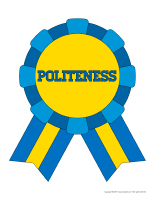
Mandalas-Politeness
(Open mandalas-Politeness) Print for each child. Have children color the mandalas to provide them with a calm moment during the day.
My favorite mark of courtesy
Have children look at a variety of books about politeness and social skills for inspiration. Invite them to draw the mark of courtesy they prefer. When they are done, they can present their drawing to the group and explain their choice.
Look me in the eyes
Divide your group into two teams. Children from each team stand next to each other on a line, so they are facing a child from the other team. Every time you ring a bell, children must “chat” with the child in front of them. Challenge them to do so while looking at each other in the eyes until they hear the bell again. Have children from one team move down so they are facing another child. Of course, the child at the far right moves to the opposite end of the line. Keep going until children have talked to and looked into the eyes of every child from the other team. Use this activity to explain the importance of looking at people when we talk to them.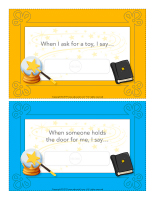
Politeness guessing game
(Open guessing game-Politeness) Print and cut out the different phrases. Roll each one up and slide them into empty toilet paper rolls. Press star-shaped stickers on each tube before dropping them in a magician’s hat (or opaque bag). Set a magic wand next to the hat or bag. Explain to your group how marks of courtesy are often called “magic words”. Tell them that this game will help them grasp how they are “politeness magicians”. Have children take turns picking a cardboard roll out of the hat or bag. Read the question. If the child knows the corresponding mark of courtesy, he can take the magic wand and wave it as he says the “magic words”. If the child does not know the correct words, another child can become the magician and pronounce them while waving the magic wand.
The politeness board
(Open polite words) Print and laminate. Set the words in a box. Children take turns picking a polite word out of the box. Read the words with them and have them stick the card on a special board.
Polite word jar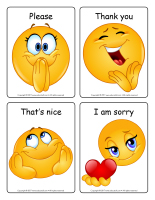
(Open polite words) Print and laminate. Use a clear jar. Every time a child uses a polite word, set a cotton ball in your jar. Once the jar is full, reward your group with a special activity.
MUSICAL ACTIVITIES
Musical politeness hat
(Open educa-decorate-Politeness) Print. Set a hat on a table along with a variety of materials (yarn pieces, buttons, fabric pieces, felt, etc.). Have children decorate the hat as they see fit. When they are done, use it for a musical hat game.
Musical politeness
(Open puppets-Politeness) Print the puppet, laminate it, and glue it on a stick. Sit in a circle with your group. To the sound of music, have them pass the puppet around the circle. When the music stops, the child holding the puppet is eliminated. The music starts up again and the game continues.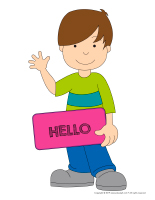
EARLY SCIENCE
We don’t share germs
Fill a platter with flour and set it on a table. Have children stand on either side of you, behind the table. Announce that, for the purpose of this experiment, you will pretend that the flour represents germs. Next, pretend to cough into the flour. It will be projected and will end up on the table and floor. Children will most likely want to cough into the flour too. Use this simple experiment to explain how sharing germs is not polite. Review the best way to cough with children (into their elbow) so that they avoid “sharing” their germs.
ARTS & CRAFTS
Table manners memory aid
Apply bright red lipstick on each child’s mouth and invite them to press their closed mouth firmly on a piece of white paper. Next, ask children to cut out their printed mouth. Help them wrap a pipe cleaner around a pencil to create a “spring” and glue it behind their printed mouth. Give each child a small ball of modeling dough and have them create a small block. They can press the bottom end of their pipe cleaner in the dough. Set children’s closed mouths in front of them at the table. They shall serve as reminders that children must keep their mouth closed when they have food in their mouth.
Paper salutations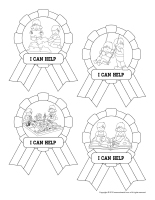
Trace each child’s hand on heavy cardboard. Help them cut out their cardboard hand and let them decorate it by drawing a smiling face. Next, they can glue a Popsicle stick behind it. Use these hands to teach children to say “hello” and “goodbye”. Every time a child arrives at daycare or leaves, encourage others to use their cardboard hand to welcome him or to say goodbye.
Helpful badges
(Open helpful badges) Print. Let children select the badge they prefer and let them color it. Once this is done, laminate the badges and have children cut them out. Help them attach a clothespin to their badge so they can wear it. You can store the badges on an indoor clothesline, installed at children’s level. When children have completed their task or activity, they can use their badge to offer their help to others. The other children will know that those who are wearing a badge are available to help out if necessary.
The apology cake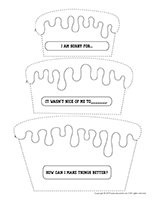
(Open apology cake) Print on heavy paper for each child. Ask children to color the three cake layers using wooden coloring pencils or markers in light colors, so they won’t hide the writing. Read the three steps required for a good apology and discuss them with your group. Next, children can cut out the layers and use adhesive tape to stick both ends of the paper strips together. This will create a three-dimensional cake that children can glue on a paper plate. Set the apology cakes on a shelf and use them to remind children of the correct way to apologize when necessary.
Crafts-Politeness
(Open models-Politeness) Print and let children decorate the models as they see fit. Cut them out and display them within your daycare.
Puppets-Politeness
(Open puppets-Politeness) Print the various models on cardboard. Ask children to cut them out and decorate them with arts & crafts materials. Glue a Popsicle stick behind each one to complete the puppets.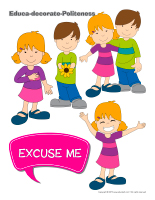
My politeness hat
(Open educa-decorate-Politeness) Print and cut out. Glue the shapes on a strip of paper and staple both ends of the strip of paper together to create a hat.
COLORING PAGES
(Open coloring pages theme-Politeness) Print for each child.
DIFFERENT WAYS TO USE THE COLORING PAGES
Identical coloring pages-Politeness
Print the same coloring page for each child and an additional copy for your model. Color only certain parts of your picture. Present the model to your group and ask them to color their picture to make it look exactly like yours.
Coloring binder-Politeness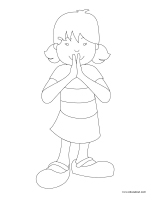
Print and laminate several coloring pages and arrange them in a binder with a few dry-erase markers. Leave everything on a table for children to explore.
Musical drawing- Politeness
Play musical drawing with your group. Give each child a coloring page. Have children sit around a table. When the music starts, they must pass the coloring pages around the table. Every time the music stops, they must color the picture in front of them until the music starts again.
Homemade puzzles- Politeness
Give each child a picture to color. When they are done, cut each picture into pieces to create unique puzzles.
Have fun!
The eductall team
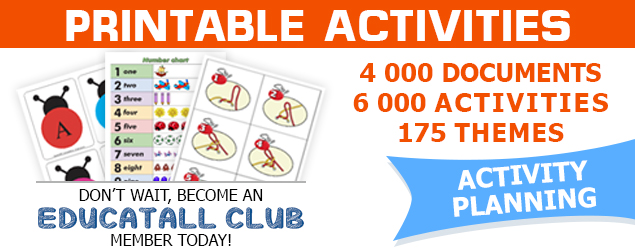
 Home
Home Theme activities
Theme activities
 Babies and toddlers
Babies and toddlers
 Arts and crafts
Arts and crafts
 Science
Science
 Creative recipes
Creative recipes
 Tips and tricks
Tips and tricks
 Special needs
Special needs
 Extra activities
Extra activities
 Educ-TV
Educ-TV
 Newsletter
Newsletter  Online store
Online store Educatall club
Educatall club

